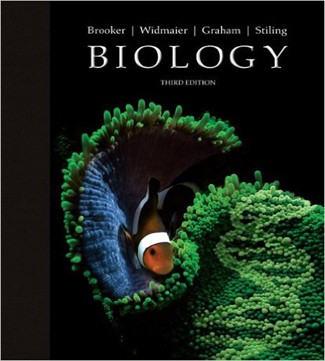Biology 3rd Edition Brooker Widmaier Graham Stiling Test Bank
$38.00
Biology 3rd Edition Brooker Widmaier Graham Stiling Test Bank Download
- Description
- Reviews (0)
Description
You will receive this product immediate after placing the order
ISBN-10: 007353224X
ISBN-13: 9780073532240 978-0073532240
Chapter 04
General Features of Cells
Multiple Choice Questions
1. Cell theory or cell doctrine is based on some basic principles. Choose the description that best addresses these principles.
A. All living things are composed of one or more cells.
B. All life is composed of two or more cells, the smallest unit of life are cells, and cell division from pre-existing cells is the only way cell continue to exist.
C. New cells come only from pre-existing cells by cell division.
D. Cells are the smallest unit of living organisms, and new cells form from pre-existing cells by cell division.
E. All living organisms are composed of one or more cells, cells are the smallest units of life, and new cells come only from pre-existing cells by cell division.
Blooms Level: 2. Understand
General LO: Apply scientific principles to energy, matter, and information transformations in biological systems.
Section: 04.07 Systems Biology of Cells: A Summary
Topic: Molecular Biology
2. The two scientists credited with the formulation of the cell theory (cell doctrine) from the 1800s are
A. Watson and Crick.
B. Schleiden and Schwann.
C. Schleiden and Hooke.
D. Schwann and Jenner.
E. Ben and Jerry.
Blooms Level: 1. Remember
General LO: Apply scientific principles to energy, matter, and information transformations in biological systems.
LO: 04.04.01 Describe the structure and organization of the cell nucleus.
Topic: General
3. To observe the three-dimensional structure of a cell the best type of microscopy would be
A. fluorescence microscopy.
B. standard light microscopy.
C. scanning electron microscopy.
D. differential-interference light microscopy.
E. transmission electron microscopy.
Blooms Level: 2. Understand
LO: 04.01.02 Describe the different types of light and electron microscopes and their uses.
Section: 04.01 Microscopy
Topic: Biotechnology
4. Transmission and scanning electron microscopy differ because
A. transmission electron microscopy has high resolution, but scanning electron microscopy does not.
B. transmission electron microscopy shows contrast, but scanning electron microscopy does not.
C. transmission electron microscopy has much higher magnification than scanning electron microscopy.
D. transmission electron microscopy shows two-dimensional ultrastructure, while the scanning electron microscopy shows three-dimensional structure.
E. transmission electron microscopy uses light as an illumination source, while scanning electron microscopy uses electron beams as an illumination source.
Blooms Level: 2. Understand
LO: 04.01.02 Describe the different types of light and electron microscopes and their uses.
Section: 04.01 Microscopy
Topic: Biotechnology
5. In order to visualize the fine structure of viruses and cytoskeletal filaments at 10-25 nanometers in diameter the type of microscopy that would be most effective is
A. standard light microscopy.
B. phase-contrast light microscopy.
C. transmission electron microscopy.
D. darkfield light microscopy.
E. differential-interference microscopy.
Blooms Level: 5. Evaluate
LO: 04.01.02 Describe the different types of light and electron microscopes and their uses.
Section: 04.01 Microscopy
Topic: Biotechnology
6. In order to gain the highest resolution when looking at a cell the best type of microscopy is
A. phase-contrast light microscopy.
B. scanning electron microscopy.
C. differential-interference light microscopy.
D. confocal microscopy.
E. fluorescence microscopy.
Blooms Level: 5. Evaluate
LO: 04.01.01 Explain the three important parameters in microscopy: resolution, contrast, and magnification.
Section: 04.01 Microscopy
Topic: Biotechnology
7. Eukaryotes such as animal and plants cells differ from prokaryotes in that prokaryotes
A. lack a true nucleus.
B. lack true DNA.
C. use the cells membrane rather than ribosomes for making proteins.
D. contain numerous organelles.
E. undergo sexual reproduction.
Blooms Level: 2. Understand
LO: 04.02.01 Compare and contrast the general structural features of prokaryotic and eukaryotic cells.
Section: 04.02 Overview of Cell Structure
Topic: Cell Structure
8. The structure that easily distinguishes a plant cell from an animal cell is
A. chloroplasts.
B. the nucleus.
C. the plasma membrane
D. the Golgi apparatus.
E. mitochondria.
Blooms Level: 1. Remember
LO: 04.02.01 Compare and contrast the general structural features of prokaryotic and eukaryotic cells.
Section: 04.02 Overview of Cell Structure
Topic: Cell Structure
9. Prokaryotes such as bacteria cells differ from eukaryotes in that prokaryotes
A. lack a membrane-bound nucleus.
B. DNA is located within the cytosol.
C. have a simpler structure relative to eukaryotes.
D. possess membrane-bound organelles.
E. they are relatively small compared with eukaryotes.
Blooms Level: 2. Understand
LO: 04.07.01 Outline the differences in complexity among bacteria, animal, and plant cells.
Section: 04.07 Systems Biology of Cells: A Summary
Topic: Cell Structure
Be the first to review “Biology 3rd Edition Brooker Widmaier Graham Stiling Test Bank”
You must be logged in to post a review.














Reviews
There are no reviews yet.